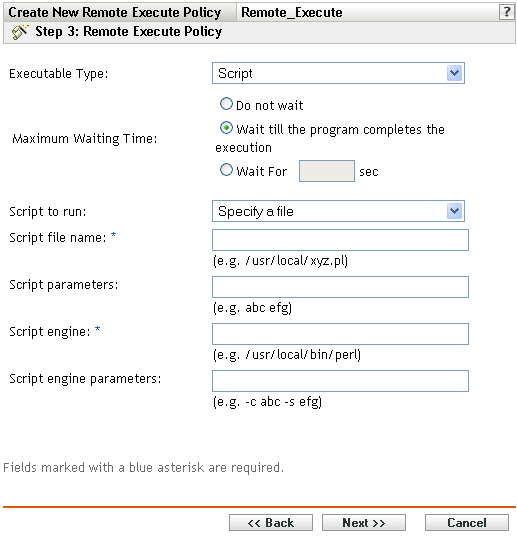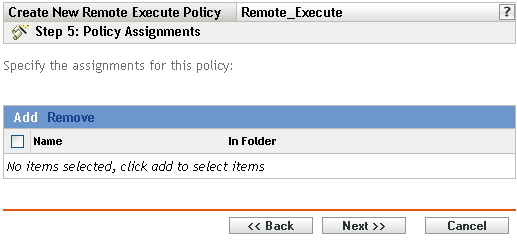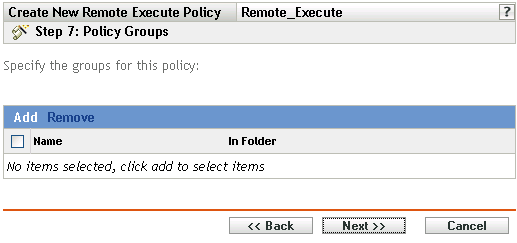20.14 Using a Remote Execute Policy to Remove Bundles and Packages from Devices
If you remove a bundle's assignments, the previously assigned devices are no longer assigned to the bundle; however, the software in the bundle remains on those devices. Likewise, if you delete a bundle by clicking the tab, selecting the box next to a bundle's name, then clicking , the software is not removed from assigned devices.
To remove the bundles and software packages from devices, you can use the Uninstall Bundle Wizard, as explained in Section 20.10, Uninstalling Bundles from Devices or you can configure a Remote Execute policy to run a script and then assign the policy to devices. You can remove a bundle, a package, or a list of packages.
You cannot remove a catalog by using a Remote Execute policy, but you can remove the bundles and packages contained in a catalog.
To configure a Remote Execute policy to remove bundles and packages from devices:
-
In the ZENworks Control Center, click the tab.
-
In the list, click , then click to display the Create New Policy page.
-
In the list, click , then click to display the Policy Name page.
-
Fill in the fields:
-
Name: (Required) Provide a unique name for the policy. The name you provide is displayed in the ZENworks Control Center interface, which is the administrative tool for ZENworks Linux Management.
For more information, see Section C.0, Naming Conventions in the ZENworks Control Center.
-
Folder: (Required) Type the name or browse to the folder that this bundle will be created in. Folders display in the ZENworks Control Center.
-
Description: Provide a short description of the policy. This description displays on the policy's Summary page in the ZENworks Control Center interface.
-
-
Click .

-
Select from the drop-down list.
-
Specify the waiting time after starting the script.
-
Select from the drop-down list.
-
Type your script in the script box.
The following table provides example scripts that you can use, depend on your needs:
NOTE:If you use rug rm package_name to remove a package that is contained in an installed bundle that contains other packages, only the specified package is removed from assigned devices. The other packages in the bundle are not removed.
If a bundle has multiple packages, when one or more package is removed, the bundle is still marked as installed in the ZENworks Control Center. Depending on the bundle's schedule, the server may re-install the package.
-
Click to display the Summary page.
-
Click to create the policy as configured per settings on the Summary page. If you click , the Remote Execute policy is created but it does not have devices assigned or a schedule. At some point in the future, you need to configure additional options for the policy by continuing with Section 17.4, Assigning Policies.
or
Click to display the Policy Assignments page to perform the following tasks:
-
Specify assignments for this policy
-
Specify the schedule for this policy
-
Specify groups for this policy

-
-
Assign the policy to the devices.
-
Click to browse for and select the appropriate Server or Workstation objects.
You can also select Folder or Group objects.
-
Click the down-arrow next to or to expand the list, then click the underlined link in the column to select the desired objects and display their names in the list box.
Assigning a policy to a Folder or Group object is the preferred method of assigning the policy. Assigning the policy to a large number of objects (for example, more than 250) might cause increased server utilization.
-
Click .
-
-
Click to display the Policy Schedule page, select the schedule to apply to the assignments from the drop-down list, which vary, depending on the schedule type you select.
The settings you configure on this page determine when the policy is assigned to devices.
The following schedules are available. Click the link in the left column for more information about each schedule type and its options.
-
Click to display the Policy Groups page.

-
(Optional) Click to open the Select Groups dialog box, then click the underlined links in the column to select the desired policy groups and display their names in the list box.
Using policy groups eases administration efforts by letting you group several policies so you can use common assignments, schedules, and so forth, rather than configuring these settings for each policy you create.
-
Click to display the Finish page.
-
Review the information on the Finish page, making any changes to the policy settings by using the button as necessary. Click to create the policy as configured per settings on the Finish page.